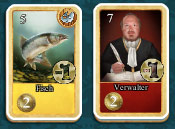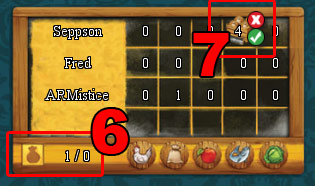Sankt Petersburg
Game preparation
With /join 2-4 players can enter the game. With /start the game begins. Alternatively, you can use the game management use.
The game

St. Petersburg is a game characterized by scarce capital. Players buy craftsmen, buildings, nobles or market cards to achieve as many win points as possible. This is rounded: After the artisan phase (green), only these are valued, after the market phase (yellow), the market is valued, after the building phase (blue) only buildings are valued and after the noble phase (orange) there is an appreciation for nobles. The 5th phase, superstructure cards (mixed), does not yield any value.

On the basis of the white underlay in the lower area (5), you can see which player is in the row and whose outlay you are looking at. In the display on the right-hand edge (4) it is always possible to recognize who is the starter in what stage of play. On the basis of the arrow you can see in which phase the game is located. The number of cards in the drawer stacks is shown at the top right in each case.
The maps
Money is displayed on the cards by the ruble symbol, winning points by a yellow coat of arms.
Craftsmen

These are mainly rubles. The purchase price is on each card top left. Below, the "3" indicates income per round (green appreciation). Craftsmen also have a symbol in the upper right corner indicating their type. This is important for the conversion cards (see below).
Market

These cards increase market value in the 5 categories. The number and market category are visible on the top right of the map. Below is the "1" as well as the other cards showing the income per round (yellow value).
Building

These are primarily winning points. Here, too, the construction costs are indicated at the top left, the winning points per round (blue score) are at the bottom right.
nobles

These are less rubles than craftsmen and less winning points than buildings, but are very interesting due to the final evaluation (see below).
Construction cards

These are characterized by a frame around their purchase price. Conversion cards are available for all three categories (handcrafters, buildings, nobles). You can only on an already designed card of the same color will be built. Only the difference of purchase prices is to be paid (at least one ruble). Green overlay cards can only be placed via a craftsman with a matching symbol.
Game sequence
At the beginning of the game, exactly two craftsmen are on top of each player. Each player has a starting capital of 25 rubles and should now buy two craftsmen. To do this, the desired cards are dragged to its playground by Drag&Drop (the player's name is always on the top right). If you don't want to buy anything, you can fit the corresponding symbol of the phase with a click.
You can also take up to three cards to use them later. To do this, the desired card is drawn to the hand symbol next to its name. If you want to play the cards later, you will open the handcard window with a click on the hand and draw the cards as usual on the field. Cards that are still on hand after playing are counted -5 points!
All cards can be bought, designed or taken on hand at any time. For example, buildings can also be built in the noble phase.
So you have four regular train options: buy (and spend), take your hand, build your hand and fit.
If all players have been fitted, the next stage stack will fill up the card edition on 8 cards (after the craftsmen at the beginning, 8 buildings will be exposed). In each phase the starter is different. The small symbols at the player's playground indicate who starts the phase. After each round, the symbols continue to travel clockwise.
At the end of each phase (except the superstructure phase) is evaluated:
- at the end of Handicraft phase receives each player for each green Map corresponding rubles and points of victory
- at the end of Market phase receives each player for each Yellow Map corresponding rubles. In addition, the majority (and second place) are rewarded with points in the individual market categories.
- at the end of Building phase receives each player for each blue Map corresponding rubles and points of victory
- at the end of noble phase receives each player for each orange Map corresponding rubles and points of victory
- at the end of Overhaul phase there are No Value
Beneficiary purchase
If you buy existing cards, you can save rubles. The same card already built is saved. Minimum price, however, is always a ruble. For example, if there are already two markets, one pays only three instead of five rubles.

At the end of each round (i.e. after the 5th phase) all unpurchased cards will get a -1. You're a ruble cheaper in the next round. Cards that already had a -1 come out of the game at the end of the round.
Market phase
At the end of the yellow market phase, the majority are evaluated in the individual market categories. in the categories chicken, grain, apple, fish and cabbage the 1st and 2nd place is determined. Points are available in the run of the game each round more. (1st round 1/0, 2nd round 2/1, 3rd round 3/1, 4th round 4/2 etc.) Showing how many points you get for the first place and the second will be left at the bottom (6).

However, each box has to be confirmed before the yellow classification. (7) Confirmation means that the player must pay the higher value of the current market value (6) in Rubel. (In this example only 1 ruble)
Playing
As soon as the last card is pulled from one of the trailing stacks, the game approaches the end. It is still played until the next superstructure phase, then the final settlement follows.
For ten rubles on hand, there is a victory point. For each non-built card on hand, 5 points are deducted.
There is a final evaluation for the nobles. If a player X has different nobles, he will receive:
| X | 1 | 2 | 3 | 4 | 5 | 6 | 7 | 8 | 9 | 10 |
| Winning points | 1 | 3 | 6 | 10 | 15 | 21 | 28 | 36 | 45 | 55 |
For more than 10 different nobles Gauß donates no more than 10. It wins the player with most winning points. At the same time, who still has the most money left.
Special cards
Some cards have special functions. These are explained here:

Zar Peter can be upgraded with any green overlay card.

The goldsmith (to lay over the gold graves) reduces the price when buying nobles by one ruble each.

The carpentry (to lay over the woodjack) reduces the price when buying buildings by one ruble each.

In the blue score, the player gets a win point for each of his outstanding nobles.

The potemkin village costs two rubles, but is counted with six rubles when overbuilding. So you save four rubles when overbuilding.

The gift allows two rubles to be exchanged directly after each blue score (maximum five points per round and gift). The player receives a corresponding symbol at the top right in this phase. There he can adjust how many of his rubles he wants to convert and confirms with "Okay". If he doesn't want to convert rubles, he just fits.

The owner of the warehouse may have up to four handcards. If the warehouse is superstructured, you can only redraw cards if you do not exceed the limit of three which is now in force after the redrawing.


The observatory normally brings a victory. However, it can be "turned" in the blue phase, but the victory point then falls for this round. Instead, you can draw a card from any stack (but not the last) and then build it, take it on your hand or drop it. In order to make this possibility visible, the observatory function is shown in the action area (2). You can then draw directly from the corresponding stack on the right side.

In the orange classification, the tax collector brings a ruble per own handicraft.
Solo variant
St. Petersburg can also be played as a solo variant. The rules are identical to the normal game. Just join the game and start as usual. The goal of the game is to achieve as high a score as possible.

